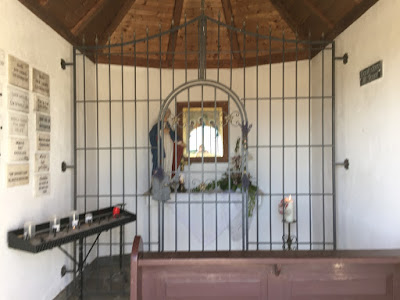 |
| Small Chapel along the Camino |
Along this part of the Camino were many small chapels. Below you can see one where people have left little plaques on the wall to the left. Many of them say "Maria hat geholfen" which means "Mary Helped" in German. On the right was one for Joseph, but overall Mary had top billing with the overwhelming majority of the plaques thanking her for help. Unlike the Internet, where you get one star and a bad review if you don't deliver, we never saw one that said "Mary Didn't Help".
We also passed a very interesting educational exhibit about bees, you can see a picture below. The bee hive opened into an area that had glass on both sides and some benches where you could sit, making it easy to watch the dances and goings on at the door without an errant bee in the hair. We even observed the eviction of an intruder! What a great idea - and pretty much in the middle of nowhere, but a nice hike or bike ride away from several villages.
 |
| Honeybee Education Center |
The day progressed through beautiful forests, and we found two wild strawberries and a single early blackberry. We had a lunch of trail mix and apples on a bench, and started back down off the ridge to the Mosel:
This part of the Mosel is serious wine country and has been since Roman times. Mosel wine is very popular, especially the Riesling, and it's unfortunate that we both don't drink. But we still profited from the great restaurants and accommodations in the region, and we enjoyed learning about efforts to grow wine with fewer chemicals. As a rule, fungicides and herbicides are used - and considering how steep some of the areas are, I can understand that hand weeding is not an option. Then again, you wonder how the Romans did it (maybe with slaves?).
When we arrived at our hotel we had a surprise: it was located in a former castle, Hotel Schloss Zell. Well, the castle was built in the 1800's and not the Middle Ages but still. And with its thick walls, the cool rooms were exactly perfect!
 |
| Hotel Schloss Zell |
We also enjoyed the decor, with stained glass windows and everything old or old looking:
After a rest and a shower, we headed out into Zell, well known for the Zeller Schwartze Katze (Black Cat) wine. You can read about the legend of the Black Cat and how the wine came to be named after it here. It was the first town that is clearly a tourist town rather than a lived-in town, as we discovered when we tried to buy a razor: no drugstore, just restaurants, places to buy clothes, places to have a glass of wine, etc. Because the Mosel valley is fairly narrow, the town is long but not very wide. We figured the drugstore was probably in the town on the other side of the river, but we didn't want to walk another five kilometers or so after just having walked 18. Instead, we settled for a very excellent meal of chantrelles on toast - a huge portion that I barely manage to finish. I'm was happy that it was chantrelle season. A month earlier, it would have been white asparagus; not bad, but I prefer chantrelles!
After dinner, we strolled around a bit and enjoyed the black cat fountain, with the town hall behind:
 |
| Black Cat Fountain and Town Hall in Zell |


